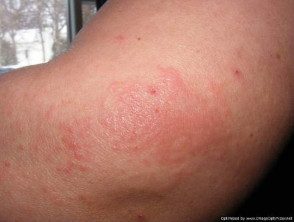What is it autoimmune progesterone dermatitis?
Autoimmune progesterone dermatitis is a rare skin condition in women that recurs cyclically corresponding to their menstrual cycles. It is believed to be a response of the skin to hormonal changes that occur just before menstruation. The skin eruption is a autoimmune response to the body's progesterone, hence its name.
What is the cause of autoimmune progesterone dermatitis?
The cause of autoimmune progesterone dermatitis is not fully understood. Some patients have had prior exposure to external progesterone in the form of oral contraceptive pills. This is believed to previously sensitize patients to react against their internal progesterone. However, not all patients withutoimmune progesterone dermatitis are exposed to previous hormonal therapy. These patients have been postulated to produce an altered form of progesterone that elicits an immune response against it. In another theory, progesterone is thought to increase the patient hypersensitivity answer to another allergen.
How does progesterone dermatitis present?
Characteristically, the skin. rashes They occur during the luteal phase or the late premenstrual phase of the cycle. This is when the blood level of the sex-the hormone increases progesterone.
A few days after menstruation, when the progesterone level falls, there is a partial or complete resolution of the rash. It will repeat during the next cycle.
A variety of eruptions have been described. The most common are urticaria and erythema multiforme Other presentations include:
- Papulovesicles (eczema-I like it)
- Cancel erythema
- Angioedema
- Mouth erosions (stomatitis and aphthous ulcers)
-
Itching (the most common complaint)
Several other skin conditions may be more severe during the period, but are not classified as autoimmune progesterone dermatitis. These include:
-
Herpes Simplex infection (herpes labialis)
-
Acne and seborrhea
- Rosacea
- Atopic dermatitis
- Contact allergy nickel
- Lupus erythematosus
- Psoriasis
On average, the rash occurs seven days before the onset of menstruation and lasts for 1 to 3 days after menstruation.
The age of onset is variable, the youngest case occurred in menarche, and the disease can start up to 48 years of age.
Autoimmune progesterone dermatitis

Image provided by Sharon Morton
How is progesterone dermatitis diagnosed?
The diagnosis is generally made from the characteristic cyclical presentation.
A skin prick test with intradermal Progesterone is helpful. Positive progesterone tests can be quite rapid, usually developing as hives within 30 minutes of inoculation, or delayed with eruptions peaking at 24–48 hours.
Provocative testing with intramuscular or oral progesterone can be performed as an alternative.
Skin biopsy it is only rarely diagnostic. A variety of histological Features have been described. Superficial perivascular mixed inflammation It is the most consistent finding.
How is progesterone dermatitis treated?
If the skin problem is mild, it can improve with current steroids (for eczema) and antihistamines (for urticaria). Serious illness can be treated with systemic corticosteroids
Progesterone production can be suppressed with hormone-based therapy. This includes the use of conjugate estrogen (American Spelling Estrogen), Ethinyl Estradiol, Tamoxifen, and Danazol.
Women with autoimmune progesterone dermatitis should try to avoid progesterone-containing medications, including the combined oral contraceptive pill, minipill, and depo injections. Specific medications to avoid include norethindrone, norgestrel, levonorgestrel.
Surgical removal of the ovaries or oophorectomy is curative in refractory cases.

